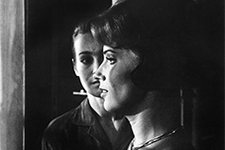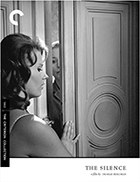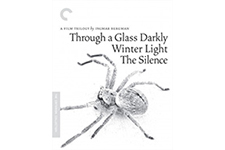The Silence (Tystnaden)
|  Ingmar Bergman’s The Silence (Tystnaden), the third of a loosely connected trilogy of “chamber films” made between 1961 and 1963, unfolds as if it were a dream, unencumbered by strict logic, and yet physically and emotionally recognizable. Most of the film takes place in a strangely deserted hotel in a fictional Eastern European city called Timoka, which in Estonian means “belonging to the executioner” (Bergman borrowed the title from a book he saw his Estonian-born wife, Käbi Laretei, reading). The city is on the brink of, or perhaps in the midst of or at the end of, a war, as tanks occasionally roll down the city streets and the sounds of battle can be heard in the distance. One day two sisters arrive in Timoka by train: Ester (Ingrid Thulin), a translator who is ill and possibly dying, and Anna (Gunnel Lindblom), her libidinous younger sister who has with her a 10-year-old son named Johan (Jörgen Lindström). Ester spends her days in her hotel room, alternately working on a new translation and battling against whatever ails her, while Johan roams the empty halls of the hotel and Anna looks for something—or someone—with which to occupy herself. Why they are in Timoka is never explained, nor is their reasoning for staying several days at the enormous hotel, which appears to be run entirely by an elderly, leering hotel steward (Håkan Jahnberg) and whose only other occupants are a troupe of dwarfs who perform at a nearby cabaret. Visually, The Silence is markedly different from Bergman’s previous film, Winter Light (1963), which was almost suffocating in its austerity, both thematic and aesthetic. Working again with cinematographer Sven Nykvist, Bergman uses the dream logic of The Silence to unlock the camera, turning the film into a swirling and intense visual tour de force that employs all manner of movement and framing to emphasize the strange, disconcerting unreality in which the characters exist. The film is replete with otherworldly images of Johan wandering the cavernous, empty halls of the hotel, and at times it takes on the tone and timbre of a horror film (surely Stanley Kubrick, who wrote a letter to Bergman in 1960s declaring him the “the greatest film-maker at work today,” studied this film in depth in preparation for The Shining [1980], whose Overlook Hotel is a modern mirror of the baroque one here). Writing in his book Images: My Life in Film, Bergman described The Silence as “contain[ing] a cinematic sensuality that I still experience with delight.” Of course, a major part of that “sensuality” involves explicit sexuality, which made the film both infamous and an international hit, much to Bergman’s apparent surprise and dismay (although one wonders if he wasn’t being purposefully mendacious when he said in an interview in the popular weekly family magazine Året runt “I had absolutely no idea that the scenes in The Silence, which I thought were rather discreet, would cause such a hell of a racket”). The film includes a scene of Ester masturbating, several shots with nudity, and two explicit sex scenes, including one in which Anna watches in mute horror/fascination while a couple passionately copulates in a theater and one later in which she has sex with the hotel’s waiter (Birger Malmsten). The frankness of these sequences (not just the exposed bodies, but the unambiguous physical movement) meant that the film was met with controversy virtually everywhere it played, included its native Sweden, where it launched weeks of debate in the newspapers and where the censorship regulations had to be changed to allow it to play unedited, a move that wound up spurring disscussion in the Swedish Parliament. Bergman’s international reputation as a filmmaker and the fact that he was the newly appointed director of the Royal Dramatic Theatre in Stockholm at the time certainly helped his case, as the change to the censorship regulation stipulated that any film that “won recognition as a valuable work of art” could not be censored. The Silence still had trouble finding distribution in foreign countries. It was initially refused a certificate in France, and the parliament in West Germany debated it at length. In England, 35 seconds had to be cut out before it was released with an X certificate, and in the U.S. nearly two minutes had to be cut out before it passed muster with the Production Code Administration. While previous Bergman films had engaged with elements of the supernatural (the character of Death, for example, in 1957’s The Seventh Seal) and had involved dream sequences (1957’s Wild Strawberries being a preeminent example), his films up until this point had always proceeded narratively according to a strict sense of dramatic realism and logic. The Silence marked a decided shift for Bergman, as the demarcation between dream and reality, which had been so clearly defined in his previous films, became permeable, to the point that the entire film itself could be a dream (or, more specifically, a nightmare). More than any other of his early films, The Silence points toward Bergman’s subsequent masterpieces Persona (1966) and Cries and Whispers (1972), which also focus on the complex relationships between women and blur the lines between reality and fantasy, the real world and dream worlds. The Silence is an important and compelling film in its own right, but what is arguably most fascinating about it is the way it points to a new and even more challenging era of Bergman’s career.
Copyright © 2019 James Kendrick Thoughts? E-mail James Kendrick All images copyright © The Criterion Collection | |||||||||||||||||||||||||||||||
Overall Rating: 


 (3.5)
(3.5)


 The Silence is available as part of The Criterion Collection’s “A Film Trilogy by Ingmar Bergman” boxset, which also includes Through a Glass Darkly (1961) and Winter Light (1963).
The Silence is available as part of The Criterion Collection’s “A Film Trilogy by Ingmar Bergman” boxset, which also includes Through a Glass Darkly (1961) and Winter Light (1963).